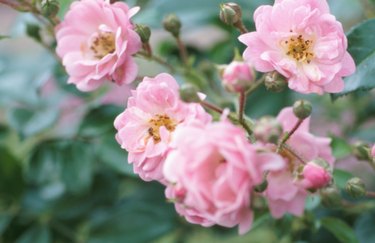
Roses, like all plants, are not healthy unless the roots are healthy. The root is the first part of the rose (Rosa spp.) that comes forth from the seed. From that root, known as the taproot, all other components of the plant will emerge, so it's important that this first root be healthy. Without a good rose root system, you are unlikely to have a rose that survives.
What Roots Do Roses Have?
Video of the Day
The rose root system starts with a taproot. That's the primary root of the rose and most other plants, and it's the root that grows downward into the soil. This woody taproot will grow side roots. These side roots will start out as fine, fibrous root hairs and grow into the soil. They will grow in nearly any direction. As the plant grows, it develops more roots, both taproots and fibrous side roots.
Video of the Day
Some of the fibrous side roots will become more woody and develop into secondary taproots or anchor roots. These roots will help the rose absorb more water and nutrients from the soil. The woody roots help the rose's root system develop structure that connect all the smaller roots to the rest of the plant.
You want to encourage the woody roots to grow downward for the best absorption of water. Deeply watering your roots will encourage these roots to grow downward. Feeder roots, however, are thin and fibrous. When you're transplanting a rose, it's important to avoid disturbing these roots as much as possible to avoid transplant shock, which occurs when the root hairs can't absorb all the water the rose needs.
The Role of Roots

Roses need both the downward-growing woody taproots and the finer tendrils and fibrous hairs that extend from the larger, thicker taproots. The taproots help the plant's root system grow a structure. Once that structure is formed, however, the non-woody fibrous roots get around to the business of feeding and nourishing the rose.
These fibrous roots, also called feeder roots, absorb air, water and nutrients from the soil. Their tendrils can extend out as far as 2 to 3 feet wide around the plant but are not usually more than 3 to 5 inches deep. They then provide these nutrients in a liquid form to the rose so the rose can produce both blooms and healthy foliage. In order for this to happen, the rose needs to be growing in healthy soil.
You want the soil around your rose root system to be porous and organically rich. Most soil contains bacteria, algae and fungi, but you will probably need to amend your soil to ensure that your rose plants have plenty of nutrients to draw from. Adding compost, mulch, aged manure, and humic acid helps. Look for an organic mixture of blood meal, alfalfa meal, seaweed and fishmeal to supplement your soil.
Keeping Roots Healthy
Healthy rose root systems start with healthy soil – that means soil that is not perpetually soggy. There must be air in the soil. Air and water should compose about 50 percent of the soil, which provides the space needed for roots to take in the nutrients a rose needs to survive and grow.

Porous soil, or soil that feels crumbly and loose, is aerated and has enough room for taproots and fibrous roots to grow into it. Compacted soil doesn't provide much welcoming space for roots, and roots will usually stay away from it. Roots are also not likely to grow into soil that is poorly drained. Soil that is aerated, well-drained, amended with minerals and teeming with organic ingredients will help your rose roots grow fast and strong.
If your soil has lots of earthworms, for example, that's a sign that your soil is rich, aerated and well-drained. Covering the roots of your rose plants with a 3-inch layer of mulch will help your rose roots by keeping the soil from becoming to hot and helping the soil to hold some moisture.